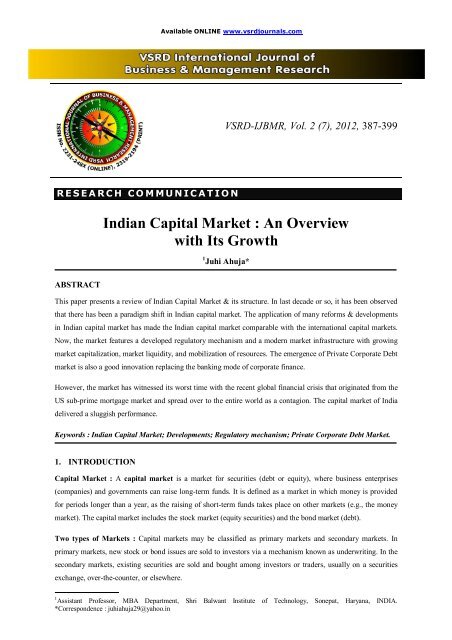Indian Capital Market : An Overview with Its Growth - vsrd ...
Indian Capital Market : An Overview with Its Growth - vsrd ...
Indian Capital Market : An Overview with Its Growth - vsrd ...
Create successful ePaper yourself
Turn your PDF publications into a flip-book with our unique Google optimized e-Paper software.
Available ONLINE www.<strong>vsrd</strong>journals.com<br />
VSRD-IJBMR, Vol. 2 (7), 2012, 387-399<br />
R E S E A R C H C O M M U N II C A T II O N<br />
<strong>Indian</strong> <strong>Capital</strong> <strong>Market</strong> : <strong>An</strong> <strong>Overview</strong><br />
<strong>with</strong> <strong>Its</strong> <strong>Growth</strong><br />
1 Juhi Ahuja*<br />
ABSTRACT<br />
This paper presents a review of <strong>Indian</strong> <strong>Capital</strong> <strong>Market</strong> & its structure. In last decade or so, it has been observed<br />
that there has been a paradigm shift in <strong>Indian</strong> capital market. The application of many reforms & developments<br />
in <strong>Indian</strong> capital market has made the <strong>Indian</strong> capital market comparable <strong>with</strong> the international capital markets.<br />
Now, the market features a developed regulatory mechanism and a modern market infrastructure <strong>with</strong> growing<br />
market capitalization, market liquidity, and mobilization of resources. The emergence of Private Corporate Debt<br />
market is also a good innovation replacing the banking mode of corporate finance.<br />
However, the market has witnessed its worst time <strong>with</strong> the recent global financial crisis that originated from the<br />
US sub-prime mortgage market and spread over to the entire world as a contagion. The capital market of India<br />
delivered a sluggish performance.<br />
Keywords : <strong>Indian</strong> <strong>Capital</strong> <strong>Market</strong>; Developments; Regulatory mechanism; Private Corporate Debt <strong>Market</strong>.<br />
1. INTRODUCTION<br />
<strong>Capital</strong> <strong>Market</strong> : A capital market is a market for securities (debt or equity), where business enterprises<br />
(companies) and governments can raise long-term funds. It is defined as a market in which money is provided<br />
for periods longer than a year, as the raising of short-term funds takes place on other markets (e.g., the money<br />
market). The capital market includes the stock market (equity securities) and the bond market (debt).<br />
Two types of <strong>Market</strong>s : <strong>Capital</strong> markets may be classified as primary markets and secondary markets. In<br />
primary markets, new stock or bond issues are sold to investors via a mechanism known as underwriting. In the<br />
secondary markets, existing securities are sold and bought among investors or traders, usually on a securities<br />
exchange, over-the-counter, or elsewhere.<br />
____________________________<br />
1 Assistant Professor, MBA Department, Shri Balwant Institute of Technology, Sonepat, Haryana, INDIA.<br />
*Correspondence : juhiahuja29@yahoo.in
Juhi Ahuja / VSRD International Journal of Business & Management Research Vol. 2 (7), 2012<br />
INDIAN <strong>Capital</strong> <strong>Market</strong><br />
Evolution : <strong>Indian</strong> Stock <strong>Market</strong>s are one of the oldest in Asia. <strong>Its</strong> history dates back to nearly 200 years ago.<br />
The Bombay Stock Exchange was inaugurated in 1899 when the brokers formally established a stock market in<br />
India. Thus, the Stock Exchange at Bombay was consolidated. After that more & more stock exchanges have<br />
emerged in India & this forms a huge capital market in India.<br />
2. EQUITY MARKET IN INDIA<br />
The <strong>Indian</strong> Equity <strong>Market</strong> is more popularly known as the <strong>Indian</strong> Stock <strong>Market</strong>. The <strong>Indian</strong> equity market has<br />
become the third biggest after China and Hong Kong in the Asian region. According to the latest report by<br />
ADB, it has a market capitalization of nearly $600 billion. As of March 2009, the market capitalization was<br />
around $598.3 billion (Rs 30.13 lakh crore) which is one-tenth of the combined valuation of the Asia region.<br />
The market was slow since early 2007 and continued till the first quarter of 2009.<br />
Stock Exchange : Stock Exchange is an Organized and regulated financial market where securities (bonds,<br />
notes, shares) are bought and sold at prices governed by the forces of demand and supply.<br />
The Role of Stock Exchanges : Stock exchanges have multiple roles in the economy. This may include the<br />
following :<br />
Raising <strong>Capital</strong> For Businesses : The Stock Exchange provide companies <strong>with</strong> the facility to raise capital for<br />
expansion through selling shares to the investing public.<br />
Facilitating Company <strong>Growth</strong> : A takeover bid or a merger agreement through the stock market is one of the<br />
simplest and most common ways for a company to grow by acquisition or fusion.<br />
Creating Investment Opportunities For Small Investors : As opposed to other businesses that require huge<br />
capital outlay, investing in shares is open to both the large and small stock investors because a person buys the<br />
number of shares they can afford. Therefore the Stock Exchange provides the opportunity for small investors to<br />
own shares of the same companies as large investors.<br />
Barometer of the Economy : At the stock exchange, share prices rise and fall depending, largely, on market<br />
forces. Share prices tend to rise or remain stable when companies and the economy in general show signs of<br />
stability and growth. <strong>An</strong> economic recession, depression, or financial crisis could eventually lead to a stock<br />
market crash. Therefore the movement of share prices and in general of the stock indexes can be an indicator of<br />
the general trend in the economy.<br />
Speculation : The stock exchanges are also fashionable places for speculation. In a financial context, the terms<br />
"speculation" and "investment" are actually quite specific. For instance, although the word "investment" is<br />
typically used, in a general sense, to mean any act of placing money in a financial vehicle <strong>with</strong> the intent of<br />
producing returns over a period of time, most ventured money—including funds placed in the world's stock<br />
markets—is actually not investment but speculation.<br />
388
Juhi Ahuja / VSRD International Journal of Business & Management Research Vol. 2 (7), 2012<br />
The <strong>Indian</strong> market has 22 stock exchanges. The larger companies are enlisted <strong>with</strong> BSE and NSE. The smaller<br />
and medium companies are listed <strong>with</strong> OTCEI (Over The counter Exchange of India).<br />
Bombay Stock Exchange (BSE) : BSE is the oldest stock exchange in Asia. The extensiveness of the<br />
indigenous equity broking industry in India led to the formation of the Native Share Brokers Association in<br />
1875, which later became Bombay Stock Exchange Limited (BSE).<br />
BSE is widely recognized due to its pivotal and pre-eminent role in the development of the <strong>Indian</strong> capital<br />
market.<br />
In 1995, the trading system transformed from open outcry system to an online screen-based order-driven trading<br />
system.<br />
<br />
<br />
<br />
<br />
<br />
<br />
The exchange opened up for foreign ownership (foreign institutional investment).<br />
Allowed <strong>Indian</strong> companies to raise capital from abroad through ADRs and GDRs.<br />
Expanded the product range (equities/derivatives/debt).<br />
Introduced the book building process and brought in transparency in IPO issuance.<br />
Depositories for share custody (dematerialization of shares).<br />
Internet trading (e-broking).<br />
BSE has a nation-wide reach <strong>with</strong> a presence in more than 450 cities and towns of India. BSE has always been<br />
at par <strong>with</strong> the international standards. It is the first exchange in India and the second in the world to obtain an<br />
ISO 9001:2000 certifications.<br />
The equity market capitalization of the companies listed on the BSE was US$1.63 trillion as of December 2010,<br />
making it the 4th largest stock exchange in Asia and the 8th largest in the world. The BSE has the largest<br />
number of listed companies in the world.<br />
As of June 2011, there are over 5,085 listed <strong>Indian</strong> companies and over 8,196 scrips on the stock exchange, the<br />
Bombay Stock Exchange has a significant trading volume. Though many other exchanges exist, BSE and the<br />
National Stock Exchange of India account for the majority of the equity trading in India.<br />
National Stock Exchange (NSE) : With the liberalization of the <strong>Indian</strong> economy, it was found inevitable to lift<br />
the <strong>Indian</strong> stock market trading system on par <strong>with</strong> the international standards. On the basis of the<br />
recommendations of high powered Pherwani Committee, the National Stock Exchange was incorporated in<br />
1992 by Industrial Development Bank of India (IDBI), Industrial Credit and Investment Corporation of India<br />
(ICICI), Industrial Finance Corporation of India (IFCI), all Insurance Corporations, selected commercial banks<br />
and others.<br />
Trading at NSE takes place through a fully automated screen-based trading mechanism which adopts the<br />
principle of an order-driven market. Trading members can stay at their offices and execute the trading, since<br />
389
Juhi Ahuja / VSRD International Journal of Business & Management Research Vol. 2 (7), 2012<br />
they are linked through a communication network. The prices at which the buyer and seller are willing to<br />
transact will appear on the screen. When the prices match the transaction will be completed and a confirmation<br />
slip will be printed at the office of the trading member.<br />
NSE has several advantages over the traditional trading exchanges. They are as follows :<br />
<br />
<br />
<br />
NSE brings an integrated stock market trading network across the nation.<br />
Investors can trade at the same price from anywhere in the country since inter-market operations are<br />
streamlined coupled <strong>with</strong> the countrywide access to the securities.<br />
Delays in communication, late payments and the malpractice’s prevailing in the traditional trading<br />
mechanism can be done away <strong>with</strong> greater operational efficiency and informational transparency in the<br />
stock market operations, <strong>with</strong> the support of total computerized network.<br />
Over The Counter Exchange of India (OTCEI) : The traditional trading mechanism prevailed in the <strong>Indian</strong><br />
stock markets gave way to many functional inefficiencies, such as, absence of liquidity, lack of transparency,<br />
unduly long settlement periods and benami transactions, which affected the small investors to a great extent. To<br />
provide improved services to investors, the country's first ring less, scrip less, electronic stock exchange -<br />
OTCEI - was created in 1992 by country's premier financial institutions - Unit Trust of India (UTI), Industrial<br />
Credit and Investment Corporation of India (ICICI), Industrial Development Bank of India (IDBI), SBI <strong>Capital</strong><br />
<strong>Market</strong>s, Industrial Finance Corporation of India (IFCI), General Insurance Corporation and its subsidiaries and<br />
CanBank Financial Services.<br />
Compared to the traditional Exchanges, OTC Exchange network has the following advantages :<br />
<br />
<br />
<br />
<br />
OTCEI has widely dispersed trading mechanism across the country which provides greater liquidity and<br />
lesser risk of intermediary charges.<br />
Greater transparency and accuracy of prices is obtained due to the screen-based scrip less trading.<br />
Since the exact price of the transaction is shown on the computer screen, the investor gets to know the exact<br />
price at which she/he is trading.<br />
Faster settlement and transfer process compared to other exchanges.<br />
Derivative <strong>Market</strong>s : The emergence of the market for derivative products such as futures and forwards can be<br />
traced back to the willingness of risk-averse economic agents to guard themselves against uncertainties arising<br />
out of price fluctuations in various asset classes. This instrument is used by all sections of businesses, such as<br />
corporate, SMEs, banks, financial institutions, retail investors, etc. According to the International Swaps and<br />
Derivatives Association, more than 90 percent of the global 500 corporations use derivatives for hedging risks in<br />
interest rates, foreign exchange, and equities.<br />
Three broad categories of participants—hedgers, speculators, and arbitragers—trade in the derivatives market.<br />
390
Juhi Ahuja / VSRD International Journal of Business & Management Research Vol. 2 (7), 2012<br />
<br />
<br />
<br />
Hedgers face risk associated <strong>with</strong> the price of an asset. They belong to the business community dealing<br />
<strong>with</strong> the underlying asset to a future instrument on a regular basis. They use futures or options markets to<br />
reduce or eliminate this risk.<br />
Speculators have a particular mindset <strong>with</strong> regard to an asset and bet on future movements in the asset’s<br />
price. Futures and options contracts can give them an extra leverage due to margining system.<br />
Arbitragers are in business to take advantage of a discrepancy between prices in two different markets. For<br />
example, when they see the futures price of an asset getting out of line <strong>with</strong> the cash price, they will take<br />
offsetting positions in the two markets to lock in a profit.<br />
3. DEBT MARKET IN INDIA<br />
Debt market refers to the financial market where investors buy and sell debt securities, mostly in the form of<br />
bonds. These markets are important source of funds, especially in a developing economy like India. India debt<br />
market is one of the largest in Asia.<br />
The most distinguishing feature of the debt instruments of <strong>Indian</strong> debt market is that the return is fixed. This<br />
means, returns are almost risk-free. This fixed return on the bond is often termed as the 'coupon rate' or the<br />
'interest rate'. Therefore, the buyer (of bond) is giving the seller a loan at a fixed interest rate, which equals to<br />
the coupon rate.<br />
3.1. Classification of <strong>Indian</strong> Debt <strong>Market</strong><br />
<strong>Indian</strong> debt market can be classified into two categories :<br />
Government Securities <strong>Market</strong> (G-Sec <strong>Market</strong>) : It consists of central and state government securities. It<br />
means that, loans are being taken by the central and state government. It is also the most dominant category in<br />
the India debt market.<br />
Bond <strong>Market</strong> : It consists of Financial Institutions bonds, corporate bonds and debentures and Public Sector<br />
Units bonds. These bonds are issued to meet financial requirements at a fixed cost and hence remove uncertainty<br />
in financial costs.<br />
Advantages : The biggest advantage of investing in <strong>Indian</strong> debt market is its assured returns. The returns that<br />
the market offer is almost risk-free (though there is always certain amount of risks, however the trend says that<br />
return is almost assured). Safer are the government securities. On the other hand, there are certain amounts of<br />
risks in the corporate, FI and PSU debt instruments. However, investors can take help from the credit rating<br />
agencies which rate those debt instruments.<br />
<strong>An</strong>other advantage of investing in India debt market is its high liquidity. Banks offer easy loans to the investors<br />
against government securities.<br />
Disadvantages : As there are several advantages of investing in India debt market, there are certain<br />
disadvantages as well. As the returns here are risk free, those are not as high as the equities market at the same<br />
391
Juhi Ahuja / VSRD International Journal of Business & Management Research Vol. 2 (7), 2012<br />
time. So, at one hand we are getting assured returns, but on the other hand, we are getting less return at the same<br />
time.<br />
Retail participation is also very less here, though increased recently.<br />
Debt Instruments : There are various types of debt instruments available that one can find in <strong>Indian</strong> debt<br />
market.<br />
Government Securities : It is the Reserve Bank of India that issues Government Securities or G-Secs on behalf<br />
of the Government of India. These securities have a maturity period of 1 to 30 years. G-Secs offer fixed interest<br />
rate, where interests are payable semi-annually.<br />
Corporate Bonds : These bonds come from PSUs and private corporations and are offered for an extensive<br />
range of tenures up to 15 years. Comparing to G-Secs, corporate bonds carry higher risks, which depend upon<br />
the corporation, the industry where the corporation is currently operating, the current market conditions, and the<br />
rating of the corporation. However, these bonds also give higher returns than the G-Secs.<br />
Certificate of Deposit : These are negotiable money market instruments. Certificate of Deposits (CDs), which<br />
usually offer higher returns than Bank term deposits, are issued in Demat form and also as a Usance Promissory<br />
Notes. There are several institutions that can issue CDs. Banks can offer CDs which have maturity between 7<br />
days and 1 year. CDs from financial institutions have maturity between 1 and 3 years. There are some agencies<br />
like ICRA, FITCH, CARE, CRISIL etc. that offer ratings of CDs. CDs are available in the denominations of ` 1<br />
Lac and in multiple of that.<br />
Commercial Papers : There are short term securities <strong>with</strong> maturity of 7 to 365 days. CPs is issued by corporate<br />
entities at a discount to face value.<br />
Zero Coupon bonds (ZCBs) : ZCBs are available at a discount to their face value. There is no interest paid on<br />
these instruments but on maturity the face value is redeemed from the RBI. A bond of face value 100 will be<br />
available at a discount say at Rs 80 and the date of maturity is after two years. This implies an interest rate on<br />
the instrument. When the bonds are redeemed Rs 100 will be paid. The securities do not carry any coupon or<br />
interest rate i.e. unlike dated securities no interest is paid out every year. When the bond matures the face value<br />
is returned. The difference between the issue price (discounted price) and face value is the return on this<br />
security.<br />
3.2. Private Corporate Debt <strong>Market</strong><br />
The private corporate debt market provides an alternative means of long-term resources (alternative to financing<br />
by banks and financial institutions) to corporate. Corporates in India have traditionally relied heavily on<br />
borrowings from banks and financial institutions (FIs) to finance their investments. Equity financing was also<br />
used, but largely during periods of surging equity prices. However, bond issuances by companies have remained<br />
limited in size and scope. Given the huge funding requirements, especially for long-term infrastructure projects,<br />
the private corporate debt market has a crucial role to play and needs to be nurtured.<br />
392
Juhi Ahuja / VSRD International Journal of Business & Management Research Vol. 2 (7), 2012<br />
Significance of the Corporate Debt <strong>Market</strong> : From the perspective of developing countries, a liquid corporate<br />
bond market can play a critical role in supporting economic development as it supplements the banking system<br />
to meet the requirements of the corporate sector for long-term capital investment and asset creation. It provides<br />
a stable source of finance when the equity market is volatile. Further, <strong>with</strong> the decline in the role of specialized<br />
financial institutions, there is an increasing realization of the need for a well-developed corporate debt market as<br />
an alternative source of finance. Corporate bond markets can also help firms reduce their overall cost of capital<br />
by allowing them to tailor their asset and liability profiles to reduce the risk of maturity and currency<br />
mismatches. A private corporate bond market is important for nurturing a credit culture and market discipline.<br />
In many Asian economies, banks have traditionally been performing the role of financial intermediation. The<br />
East Asian crisis of 1997 underscored the limitations of weak banking systems. The primary role of a banking<br />
system is to create and maintain liquidity that is needed to finance production <strong>with</strong>in a short-term horizon. The<br />
crisis showed that over-reliance on bank lending for debt financing exposes an economy to the risk of a failure<br />
of the banking system. Banking systems, therefore, cannot be the sole source of long-term investment capital<br />
<strong>with</strong>out making an economy vulnerable to external shocks. In times of financial distress, when banking sector<br />
becomes vulnerable, the corporate bond markets act as a buffer and reduce macroeconomic vulnerability to<br />
shocks and systemic risk through diversification of credit and investment risks. By contributing to a more<br />
diverse financial system, a bond market can promote financial stability.<br />
State of the Corporate Debt <strong>Market</strong> in India : In India, banks and FIs have traditionally been the most<br />
important external sources of finance for the corporate sector. India has traditionally been a predominantly<br />
bank-based system. This picture is generally characteristic of most Asian economies.<br />
In the 1990s, the equity market in India witnessed a series of reforms, which helped in bringing it on par <strong>with</strong><br />
international standards. However, the corporate debt market has not been able to develop due to lack of market<br />
infrastructure and a comprehensive regulatory framework. For a variety of reasons, the issuers resorted to<br />
‘private placement’ of bonds as opposed to ‘public issues’ of bonds. The issuances of bonds to the public have<br />
declined sharply since the early 1990s. From an annual average of Rs.7,513 crore raised by way of public debt<br />
issues during 1990-95, the mobilization fell to Rs.5,526 crore during 1995-2000 and further to Rs.4,433 crore<br />
during 2000-05. In 2005-06, the mobilisation of funds by public issue of debt shrank to a measly sum of Rs.245<br />
crore, while the resources raised by way of private placement of debt swelled to Rs.96,369 crore. The share of<br />
resources raised by private placements in total debt issues correspondingly increased from 69.1 per cent in 1995-<br />
96 to 99.8 per cent in 2005-06. This trend continued in 2006-07 also & further.<br />
3.3. Private Placement <strong>Market</strong> in India<br />
In private placement, resources are raised privately through arrangers (merchant banking intermediaries) who<br />
place securities <strong>with</strong> a limited number of investors such as financial institutions, corporate and high net worth<br />
individuals. Under Section 81 of the Companies Act, 1956, a private placement is defined as ‘an issue of shares<br />
or of convertible securities by a company to a select group of persons’. <strong>An</strong> offer of securities to more than 50<br />
persons is deemed to be a public issue under the Act.<br />
Corporate access the private placement market because of its certain inherent advantages. First, it is a cost and<br />
393
Juhi Ahuja / VSRD International Journal of Business & Management Research Vol. 2 (7), 2012<br />
time-effective method of raising funds. Second, it can be structured to meet the needs of the entrepreneurs.<br />
Third, private placement does not require detailed compliance of formalities as required in public or rights<br />
issues.<br />
The private placement market was not regulated until May 2004. In view of the mushrooming growth of the<br />
market and the risk posed by it, SEBI prescribed that the listing of all debt securities, irrespective of the mode of<br />
issuance, i.e., whether issued on a private placement basis or through public/rights issue, shall be done through a<br />
separate listing agreement. The Reserve Bank also issued guidelines to the financial intermediaries under its<br />
purview on investments in non-SLR securities including, private placement. In June 2001, boards of banks were<br />
advised to lay down policy and prudential limits on investments in bonds and debentures, including cap on<br />
unrated issues and on a private placement basis. The policy laid down by banks should prescribe stringent<br />
appraisal of issues, especially by non-borrower customers, provide for an internal system of rating, stipulate<br />
entry-level minimum ratings/quality standards and put in place proper risk management systems.<br />
The private placement market in India, which shot into prominence in the early 1990s, has grown sharply in<br />
recent years. The resource mobilization by way of private placements increased from Rs.13,361 crore in 1995-<br />
96 to Rs.96,369 crore in 2005-06, recording an average annual growth of over 25 per cent during the decade.<br />
Further, the private placement market appears to be growing at the expense of the public issues market, which<br />
has some distinct advantages in the form of wider participation by the investors and, thus, diversification of the<br />
risk.<br />
With the intent of the development of the corporate bond market along sound lines, some initiatives were taken<br />
by the SEBI in the past few years. These measures largely aimed at improving disclosures in respect of privately<br />
placed debt issues.<br />
4. REGULATORY FRAMEWORK<br />
The Securities and Exchange Board of India (SEBI) is the regulatory authority established under the SEBI Act<br />
1992, in order to protect the interests of the investors in securities as well as promote the development of the<br />
capital market. It involves regulating the business in stock exchanges; supervising the working of stock brokers,<br />
share transfer agents, merchant bankers, underwriters, etc; as well as prohibiting unfair trade practices in the<br />
securities market.<br />
394
Juhi Ahuja / VSRD International Journal of Business & Management Research Vol. 2 (7), 2012<br />
Securities and Exchange Board of India<br />
SEBI Bhavan, Mumbai headquarters<br />
4.1. History<br />
Initially SEBI was a non statutory body <strong>with</strong>out any statutory power. However in 1995, the SEBI was given<br />
additional statutory power by the Government of India through an amendment to the securities and Exchange<br />
Board of India Act 1992. In April, 1998 the SEBI was constituted as the regulator of capital market in India<br />
under a resolution of the Government of India.<br />
4.2. The basic objectives of the Board were identified as :<br />
<br />
<br />
<br />
<br />
to protect the interests of investors in securities;<br />
to promote the development of Securities <strong>Market</strong>;<br />
to regulate the securities market and<br />
For matters connected there<strong>with</strong> or incidental thereto.<br />
4.3. Responsibilities<br />
SEBI has to be responsive to the needs of three groups, which constitute the market:<br />
395
Juhi Ahuja / VSRD International Journal of Business & Management Research Vol. 2 (7), 2012<br />
<br />
<br />
<br />
the issuers of securities<br />
the investors<br />
The market intermediaries.<br />
4.4. Role Functions of SEBI<br />
The role or functions of SEBI are discussed below :<br />
To protect the interests of investors through proper education and guidance as regards their investment in<br />
securities. For this, SEBI has made rules and regulation to be followed by the financial intermediaries such as<br />
brokers, etc. SEBI looks after the complaints received from investors for fair settlement. It also issues booklets<br />
for the guidance and protection of small investors.<br />
To regulate and control the business on stock exchanges and other security markets. For this, SEBI keeps<br />
supervision on brokers. Registration of brokers and sub-brokers is made compulsory and they are expected to<br />
follow certain rules and regulations. Effective control is also maintained by SEBI on the working of stock<br />
exchanges.<br />
To provide suitable training to intermediaries.<br />
To register and regulate the working of mutual funds including UTI (Unit Trust of India). SEBI has made rules<br />
and regulations to be followed by mutual funds. The purpose is to maintain effective supervision on their<br />
operations & avoid their unfair and anti-investor activities.<br />
To promote self-regulatory organization of intermediaries. SEBI is given wide statutory powers. However, selfregulation<br />
is better than external regulation. Here, the function of SEBI is to encourage intermediaries to form<br />
their professional associations and control undesirable activities of their members.<br />
To regulate and control the fraudulent & unfair practices which may harm the investors and healthy growth of<br />
capital market.<br />
To issue guidelines to companies regarding capital issues. Separate guidelines are prepared for first public issue<br />
of new companies, for public issue by existing listed companies and for first public issue by existing private<br />
companies. SEBI is expected to conduct research and publish information useful to all market players (i.e. all<br />
buyers and sellers).<br />
To conduct inspection, inquiries & audits of stock exchanges, intermediaries and self-regulating organizations<br />
and to take suitable remedial measures wherever necessary. This function is undertaken for orderly working of<br />
stock exchanges & intermediaries.<br />
To restrict insider trading activity through suitable measures. This function is useful for avoiding undesirable<br />
activities of brokers and securities scams.<br />
396
Juhi Ahuja / VSRD International Journal of Business & Management Research Vol. 2 (7), 2012<br />
4.5. Powers<br />
For the discharge of its functions efficiently, SEBI has been invested <strong>with</strong> the necessary powers which are :<br />
<br />
<br />
<br />
<br />
<br />
<br />
<br />
To approve by laws of stock exchanges.<br />
To require the stock exchange to amend their by laws.<br />
Inspect the books of accounts and call for periodical returns from recognized stock exchanges.<br />
Inspect the books of accounts of financial intermediaries.<br />
Levy fees and other charges on the intermediaries for performing its functions.<br />
Delegate powers exercisable by it.<br />
Prosecute and judge directly the violation of certain provisions of the companies Act.<br />
5. EFFECT OF INFLATION ON CAPITAL MARKET<br />
Prices of stocks are determined by the net earnings of a company. It depends on how much profit, the company<br />
is likely to make in the long run or the near future. If it is reckoned that a company is likely to do well in the<br />
years to come, the stock prices of the company will escalate. On the other hand, if it is observed from trends that<br />
the company may not do well in the long run, the stock prices will not be high. In other words, the prices of<br />
stocks are directly proportional to the performance of the company. In the event when inflation increases, the<br />
company earnings (worth) will also subside. This will adversely affect the stock prices and eventually the<br />
returns.<br />
Effect of inflation on stock market is also evident from the fact that it increases the rates if interest. If the<br />
inflation rate is high, the interest rate is also high. In the wake of both (inflation and interest rates) being high,<br />
the creditor will have a tendency to compensate for the rise in interest rates. Therefore, the debtor has to avail of<br />
a loan at a higher rate. This plays a significant role in prohibiting funds from being invested in stock markets.<br />
When the government has enough funds to circulate in the market, the cost of goods, services usually go up.<br />
This leads to the decrease in the purchasing power of individuals. The value of money also decreases. In a nut<br />
shell, for the economy to flourish, inflation and stock market ought to be more conforming and predictable.<br />
397
Juhi Ahuja / VSRD International Journal of Business & Management Research Vol. 2 (7), 2012<br />
6. THE INDIAN CAPITAL MARKET : GROWTH WITH GOVERNANCE<br />
A report released by PricewaterhouseCoopers (PwC) and ASSOCHAM, charts the journey of the <strong>Indian</strong> capital<br />
market from the pre-reform era to the liberalised market of this decade. The report emphasises the importance of<br />
SEBI, as the supreme regulator of the <strong>Indian</strong> capital market, and the various steps taken by SEBI to maintain<br />
investor confidence in the market. The report states that while, India has achieved the desired acceptability on<br />
the global map, however the change must continue, to address the challenges of modern day, newer products<br />
needs to be introduced to ensure that innovation continues, while ensuring market best practices to take <strong>Indian</strong><br />
capital markets to the next level of globalisation. The imperative need to bring forward 2nd generation financial<br />
sector reforms will propel the <strong>Indian</strong> capital markets to possibly double digit GDP growth.<br />
The capital market plays a vital role in fostering economic growth of the country, as it augments the quantities<br />
of real savings; increases the net capital inflow from abroad; raises the productivity of investments by improving<br />
allocation of investible funds; and reduces the cost of capital in the economy.<br />
7. REFORMS IN CAPITAL MARKET OF INDIA<br />
The major reform undertaken in capital market of India includes :<br />
Establishment of SEBI : The Securities and Exchange Board of India (SEBI) was established in 1988. It got a<br />
legal status in 1992. SEBI was primarily set up to regulate the activities of the merchant banks, to control the<br />
operations of mutual funds, to work as a promoter of the stock exchange activities and to act as a regulatory<br />
authority of new issue activities of companies.<br />
Establishment of Creditors Rating Agencies : Three creditors rating agencies viz. The Credit Rating<br />
Information Services of India Limited (CRISIL - 1988), the Investment Information and Credit Rating Agency<br />
of India Limited (ICRA - 1991) and Credit <strong>An</strong>alysis and Research Limited (CARE) were set up in order to<br />
assess the financial health of different financial institutions and agencies related to the stock market activities. It<br />
is a guide for the investors also in evaluating the risk of their investments.<br />
Increasing of Merchant Banking Activities : Many <strong>Indian</strong> and foreign commercial banks have set up their<br />
merchant banking divisions in the last few years. These divisions provide financial services such as<br />
underwriting facilities, issue organizing, consultancy services, etc.<br />
Rising Electronic Transactions : Due to technological development in the last few years. The physical<br />
transaction <strong>with</strong> more paper work is reduced. It saves money, time and energy of investors. Thus it has made<br />
investing safer and hassle free encouraging more people to join the capital market.<br />
Growing Mutual Fund Industry : The growing of mutual funds in India has certainly helped the capital<br />
market to grow. Public sector banks, foreign banks, financial institutions and joint mutual funds between the<br />
<strong>Indian</strong> and foreign firms have launched many new funds. A big diversification in terms of schemes, maturity,<br />
etc. has taken place in mutual funds in India. It has given a wide choice for the common investors to enter the<br />
capital market.<br />
Growing Stock Exchanges : The numbers of various Stock Exchanges in India are increasing. Initially the BSE<br />
398
Juhi Ahuja / VSRD International Journal of Business & Management Research Vol. 2 (7), 2012<br />
was the main exchange, but now after the setting up of the NSE and the OTCEI, stock exchanges have spread<br />
across the country. Recently a new Inter-connected Stock Exchange of India has joined the existing stock<br />
exchanges.<br />
Investor's Protection : Under the purview of the SEBI the Central Government of India has set up the Investors<br />
Education and Protection Fund (IEPF) in 2001. It works in educating and guiding investors. It tries to protect the<br />
interest of the small investors from frauds and malpractices in the capital market.<br />
<strong>Growth</strong> of Derivative Transactions : Since June 2000, the NSE has introduced the derivatives trading in the<br />
equities. In November 2001 it also introduced the future and options transactions. These innovative products<br />
have given variety for the investment leading to the expansion of the capital market.<br />
Commodity Trading : Along <strong>with</strong> the trading of ordinary securities, the trading in commodities is also recently<br />
encouraged. The Multi Commodity Exchange (MCX) is set up. The volume of such transactions is growing at a<br />
splendid rate.<br />
These reforms have resulted into the tremendous growth of <strong>Indian</strong> capital market.<br />
8. REFERENCES<br />
[1] Stock Exchange Official Directory, Vol.2 (9) (iii), Bombay Stock Exchange, Bombay<br />
[2] http://business.mapsofindia.com/india-market/debt.html<br />
[3] Bank for International Settlements, 2006<br />
[4] RBI; National Stock Exchange of India Limited<br />
[5] http://www.equitymaster.com<br />
[6] http://www.businessdictionary.com/definition/stock-exchange.html<br />
[7] http://www.yeahindia.com/c-india1.htm<br />
[8] http://en.wikipedia.org/wiki/<strong>Capital</strong>_market<br />
[9] http://kalyan-city.blogspot.com/2010/09/reforms-developments-in-indian-capital.html<br />
[10] http://www.pwc.com/in/en/publications/india-captial-market-11-feb.jhtml<br />
[11] http://business.gov.in/business_financing/capital_market.php<br />
[12] http://www.economywatch.com/market/capital-market/indian.html<br />
<br />
399

















